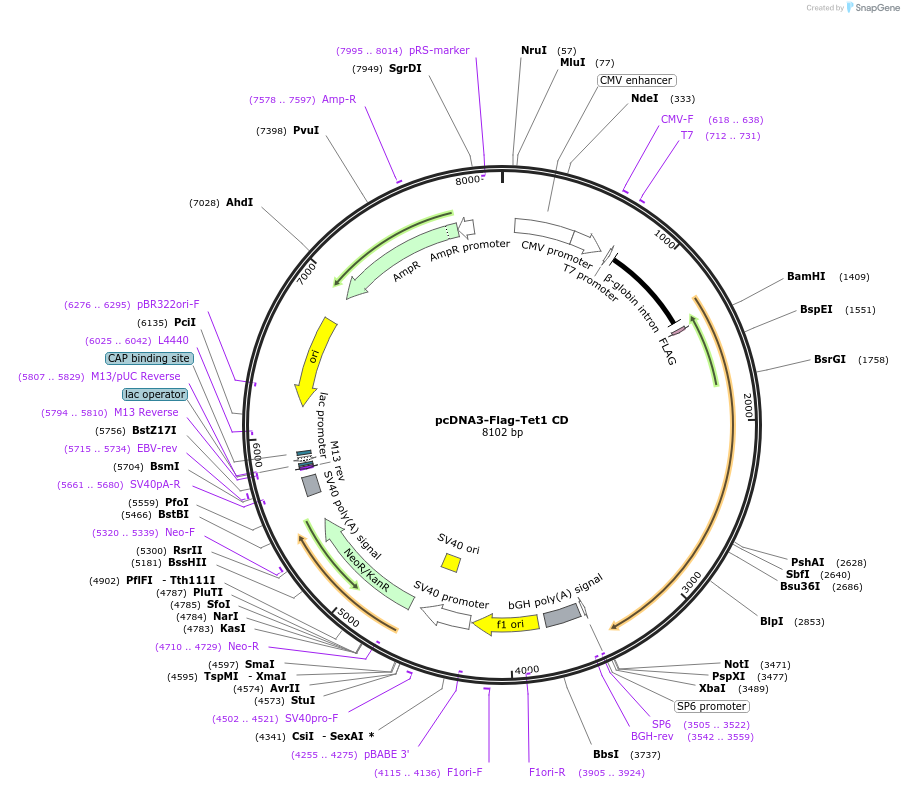-
PurposeExpress flag-tagged mouse Tet1 catalytic domain.
-
Depositing Lab
-
Sequence Information
Ordering
| Item | Catalog # | Description | Quantity | Price (USD) | |
|---|---|---|---|---|---|
| Plasmid | 70129 | Standard format: Plasmid sent in bacteria as agar stab | 1 | $89 | |
Backbone
-
Vector backbonepcDNA3
- Backbone size w/o insert (bp) 6000
- Total vector size (bp) 8000
-
Modifications to backboneA rabbit beta globin intron is inserted.
-
Vector typeMammalian Expression
Growth in Bacteria
-
Bacterial Resistance(s)Ampicillin, 100 μg/mL
-
Growth Temperature37°C
-
Growth Strain(s)DH5alpha
-
Copy numberHigh Copy
Gene/Insert
-
Gene/Insert nameTen-Eleven Translocation 1
-
SpeciesM. musculus (mouse)
-
MutationThe plasmid expresses TET1 catalytic domain.
-
Entrez GeneTet1 (a.k.a. 2510010B09Rik, Cxxc6, D10Ertd17e, LCX, mKIAA1676)
-
Tag
/ Fusion Protein
- flag (N terminal on backbone)
Cloning Information
- Cloning method Restriction Enzyme
- 5′ cloning site BamHI (unknown if destroyed)
- 3′ cloning site XbaI (unknown if destroyed)
- 5′ sequencing primer CMV
- 3′ sequencing primer SP6
- (Common Sequencing Primers)
Resource Information
-
Articles Citing this Plasmid
Terms and Licenses
-
Academic/Nonprofit Terms
-
Industry Terms
- Not Available to Industry
Trademarks:
- Zeocin® is an InvivoGen trademark.
Depositor Comments
*modified pcDNA3 vector with a beta globulin intron inserted. This insertion can help stabilize the transcripts and is particularly useful for the expression of large genes, such as p300 and Tet proteins.
For additional information about how this plasmid was created and used, please see Ito et al., Nature 2010 Pubmed ID: 20639862
These plasmids were created by your colleagues. Please acknowledge the Principal Investigator, cite the article in which the plasmids were described, and include Addgene in the Materials and Methods of your future publications.
-
For your Materials & Methods section:
pcDNA3-Flag-Tet1 CD was a gift from Yi Zhang (Addgene plasmid # 70129 ; http://n2t.net/addgene:70129 ; RRID:Addgene_70129) -
For your References section:
Tet proteins can convert 5-methylcytosine to 5-formylcytosine and 5-carboxylcytosine. Ito S, Shen L, Dai Q, Wu SC, Collins LB, Swenberg JA, He C, Zhang Y. Science. 2011 Sep 2;333(6047):1300-3. doi: 10.1126/science.1210597. Epub 2011 Jul 21. 10.1126/science.1210597 PubMed 21778364



